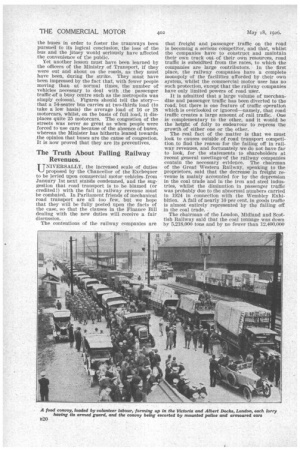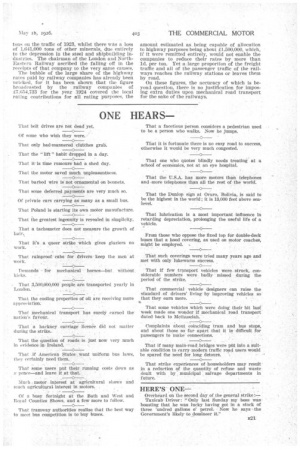The Truth About Falling Railway Revenues.
Page 2

Page 3

If you've noticed an error in this article please click here to report it so we can fix it.
UNIVERSALLY, the increased scale of duties proposed by the Chancellor of the Exchequer to be levied upon commercial motor vehicles, from January 1st next stands condemned, and the suggestion that road transport is to be blamed (or credited!) with the fall in railway revenue must be combated. In Parliament friends of mechanical road transport are all too few, but we hope that they will be fully posted upon the facts of the case, so that the clauses in the Finance Bill dealing with the new duties will receive a fair discussion.
The contentious of the railway companies are that freight and passenger traffic on the road is becoming a serious competitor, and that, whilst the companies have to construct and maintain their own track out of their own resources, road traffic is subsidized from the rates, to which the companies are large contributors. In the first place, the railway companies have a complete monopoly of the facilities afforded by their own system, whilst the commercial motor user has no such protection, except that the railway companies have only limited powers of road user. It is admitted that a large volume of merehandize and passenger traffic has been diverted to the road, but there is one feature of traffic operation which is overlooked or ignored—namely, that road traffic creates a large amount .of rail traffic. One is complementary to the other, and it would be the height of folly to endeavour to repress the growth of either one or the other.
The real fact of the matter is that we must look to causes outside of road transport competition to find the reason for the falling off in railway revenues, and fortunately we do not have far to look, for the statements to shareholders at recent general rneetings.of the railway companies contain the necessary evidence. The chairman of the Great Western Railway, speaking to the proprietors, said that the decrease in freight revenue is mainly accounted for by the depression in the coal trade and in the iron and steel industries, whilst the diminution in passenger traffic was probably due to the abnormal numbers carried in 1924 in connection with the Wembley Exhibition. A fall of nearly 10 per cent, in goods traffic Is almost entirely represented by the falling off in the coal trade.
The chairman of the London, Midland and Scottish Railway said that the coal tonnage was down by 5,218,000 tons and by no fewer than 12,400,000 tons on the. traffic of 1923, whilst there was a loss of 1,041,000 tons of other minerals, due entirely to the depression in the steel and shipbuilding industries. The chairman of the London and NorthEastern Railway ascribed the falling off in the receipts of that company to the very same causes.
The bubble of the large share of the highway rates paid by railway companies has already been wicked, for it has been shown that the figure broadcasted by the railway companies of 17,054,733 for the year 1924 covered the local rating contributions for all rating purposes, the amount estimated as being capable of allocation to highway purposes being about 11,500,000, which, if It were remitted entirely, would not enable the companies to reduce their rates by more than 1d. per ton. Yet a-large proportion of the freight traffic and all of the passenger traffic of the Tailways reaches the railway stations or leaves them by road.
On these figures, the accuracy of which is beyond question, there is no justification for imposing extra duties upon mechanical road transport for the sake of the railways.


























